Who is using sod in the winter months? Sod is used by large construction firms that build bioswales and settling basins where the bio-swales need to be operational very soon and there is too much risk in allowing seed to germinate and grow.
One of our large contractor is purchasing sod by the acre for their bio-swale project. 🙂
Below is a video showing the bioswale using sod (not our contractor) so you can see the application.
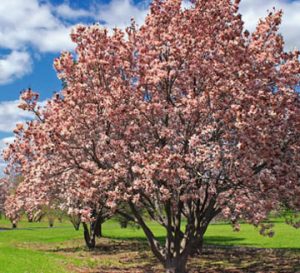
The cold and rainy season is here in the Pacific Northwest. Now is the time to prepare your lawn for winter. These are the steps that you should be following.
- Mow your lawn at regular height until the growth stops. The growth slowdown has already occurred for many lawns.
- Apply lime and a winter type fertilizer. This will slowly be absorbed by the grass roots and prepare your lawn for spring growth.
- Winterize lawn equipment by changing the oil and emptying the fuel tank. Place into storage.
- Remove leaves: Keep your lawn free of leaves so they don’t smother it over the winter.
Then you are ready to enjoy a warm fire and a good book as you wait for the coming of spring.
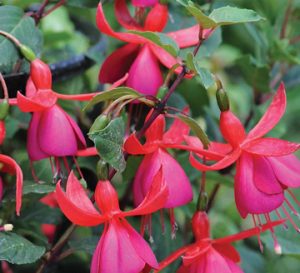
This tropical looking flowering shrub will bloom all summer and through the fall. The Fuchsia pictured in this blog posting was photographed just a week ago in a Vancouver, WA garden
Winter hardy Fuchsias not only grow, but thrive in the Portland – Vancouver, WA area. They need sun, with full sun being best. Plant them in a well-drained location. Sandy soils with added organic material work well.
The best time to plant is in the spring of the year, but planting can be done through the summer and into early fall.
Winter care of cold hardy (winter hardy) Fuchsias: Allow the frost to kill all of the leaves and trim back the all the non-woody growth. In the spring when green shoots appear, prune the plant back hard and work into the soil a general fertilizer. Fertilize again in August.
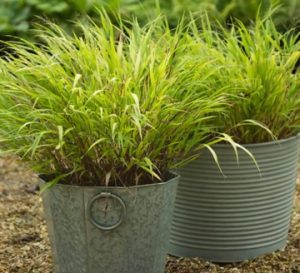
This is a graceful looking ornamental grass that is a member of the Hakonechloa family. Its bright colors and textures light up the garden. Japanese forest grass does best in full shad or partial shade. It is slow growing and takes little care once it is established.
Japanese forest grass is available in striped (variegated) or solid and comes in several colors. Colors include Gold or Green with white or gold stripes. Their elegant textures add character to your garden. It typically grows 18-24 inches high with its blades forming arches that flow back down to the ground.
Soil should be well draining and kept moist. Add soil amendments for best growing conditions. Grows well in partial shade. Combines well with Hastas in the garden.
Older plants can be dug up and divided to form new bunches. This dividing is best done in the spring or fall. Remove the dead leaves in early spring before the new growth forms.
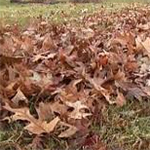 Fall is here and winter will be soon. Winter is the season when you spend the least amount of time thinking about your lawn. There are steps you need to take in late fall to make sure your lawn is vibrant and healthy for next spring.
Fall is here and winter will be soon. Winter is the season when you spend the least amount of time thinking about your lawn. There are steps you need to take in late fall to make sure your lawn is vibrant and healthy for next spring.
Leaf clean-up: Carefully remove the blanket of leaves that will fall in the next 2 months. A covering of leaves if left over the winter will smother and severely weaken your lawn. Remove any objects or equipment that can block sunlight over the coming long rainy season.
Final Fertilization: In late fall (usually November in the Pacific Northwest) feed your lawn with a good winter type fertilizer. Much like many animals that will bulk up for the winter, lawns will accumulate the fertilizer in its roots to make ready for a spring emergence.
When spring does come, your lawn will emerge from its winter slumber with healthy and lush new growth.
Tips from Far West Turf Farm and Nursery serving Vancouver, WA and Portland, Oregon. Your Vancouver, WA turf farm.
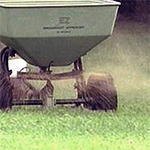 In the Portland and Vancouver WA areas lawns do not go completely dormant over the winter. Fall is the best time to prepare your lawn for the coming spring with a fall winter fertilizer and a treatment of lime.
In the Portland and Vancouver WA areas lawns do not go completely dormant over the winter. Fall is the best time to prepare your lawn for the coming spring with a fall winter fertilizer and a treatment of lime.
Fertilize your lawn with a slow release Nitrogen product usually sold as a winterizer or Fall-Winter fertilizer. This would typically be a 18-4-12 fertilizer with slow release Nitrogen. . This way the nitrogen is available for the coming spring as your lawn wakes up and produces a green healthy lawn quicker.
The fall is also a great time to apply lime to the lawn to control acidity. A lime treatment will control the soil pH (acidity) and help the grass roots absorb the fertilizer.
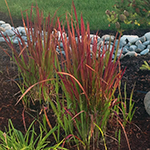 Japanese Blood Grass is a popular ornamental grass. It is known for the deep red hues that develop in the latter part of the summer and carry into the fall. Japanese blood grass will typically stand 1-2 feet tall and grow in clumps 2 feet in diameter. This makes an excellent accent in the garden.
Japanese Blood Grass is a popular ornamental grass. It is known for the deep red hues that develop in the latter part of the summer and carry into the fall. Japanese blood grass will typically stand 1-2 feet tall and grow in clumps 2 feet in diameter. This makes an excellent accent in the garden.
Japanese Blood Grass grows well in full sun and will also do well in partial shade. It does take a good exposure to the sun to develop the characteristic blood red color each summer. It prefers moist to wet soil that drains quickly.
Imperata cylindrical will typically die back in late fall or early winter. As part of your winter maintenance, trim away the dead grass on each clump to a height of 2-3 inches. Trimming too short can damage the crown that will sprout new growth next spring.
Plant the Blood Grass clumps no closer than 2 feet apart. Japanese Blood grass will continue to spread by sending out lateral runners that are just 1-2 inches below the soil surface. You can contain a clump by placing a 6 inch deep barrier around a clump. This grass also grows well in containers or large wooden barrels.
Japanese Blood Grass does not need to be fertilized.
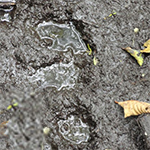 In the Pacific Northwest you can’t plan the weather, even within a single day. How do you handle laying sod when a cloudburst hits? The worst damage comes from just walking back and forth and your footprints will create an uneven surface.
In the Pacific Northwest you can’t plan the weather, even within a single day. How do you handle laying sod when a cloudburst hits? The worst damage comes from just walking back and forth and your footprints will create an uneven surface.
The ground for your new lawn area needs to be prepared properly, graded smooth and compacted. The soil needs to be dry enough to work to create the proper base for your new lawn. More on how to prepare the ground for sodding.
If rain arrives on the day of lawn installation, lay down sheets of plywood and this will prevent foot prints from being embedded in your prepared soil. The plywood spreads your weight much like a snowshoe allows you to walk on top of snow. You can also use plastic sheeting to keep rain off the pallets of sod waiting for installation. Take care not to walk on the freshly laid sod until the soil dries out a bit.
You have to use good sense and realize there is no way to lay sod if the ground is a soupy mess. The plywood method works to protect an already flat and firm ground.
 Some trees have shallow roots that rise up over time. An example is this maple tree to the left. These exposed tree roots can be a major annoyance when they are in your lawn area. They are difficult to mow over or even walk over. How can you treat these areas?
Some trees have shallow roots that rise up over time. An example is this maple tree to the left. These exposed tree roots can be a major annoyance when they are in your lawn area. They are difficult to mow over or even walk over. How can you treat these areas?
You don’t want to cut out the tree roots because the resulting root damage can permanently damage or kill the tree.
You have two choices. You can remove the grass in a 4-6 foot circle around the tree and plant a ground cover or coat over with a layer of bark dust. You could also conceal tree roots by adding 2-3 inches of soil to fill over the roots and then sod over this leveled ground.
When sodding over tree roots, be sure to compact the soil well before laying the sod. Water the freshly installed sod and keep moist for about 2 weeks allowing it to take root. For the best sod, go to your local sod farm.
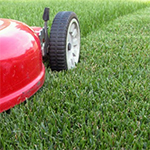 Summer is winding down and we are moving in to a cooler fall season. The ground is still warm so fall is the perfect time for lawn maintenance and preparing for the coming winter.
Summer is winding down and we are moving in to a cooler fall season. The ground is still warm so fall is the perfect time for lawn maintenance and preparing for the coming winter.
Lawn Length: The cooler temperatures and warm soil temperature encourages grass growth. Don’t let your grass get too long before mowing. You should plan on only cutting about 1/3 of the grass blade in a single mowing. Tip: increase your mowing height ½”-1” during periods of high growth.
Dethatch: Having a thin layer of dead matted grass (thatch) of up to ½ inch is normal. Remove this layer by raking or power raking to encourage growth by allowing air, water and fertilizer to reach the roots. More on dethatching
Aeration: Over time your lawn area can be compacted with thin or bare spots. Aeration punches small holes in the turf that encourages lawn growth. Fall is the best time to do aeration. More on aeration and overseeding
Lawn Replacement: If you have problem areas and you have addressed them with soil testing, look at replacing problem areas or your entire lawn area. Fall is an ideal time to replace a damaged lawn. You can purchase sod or reseed your lawn. More on seed vs. sod

